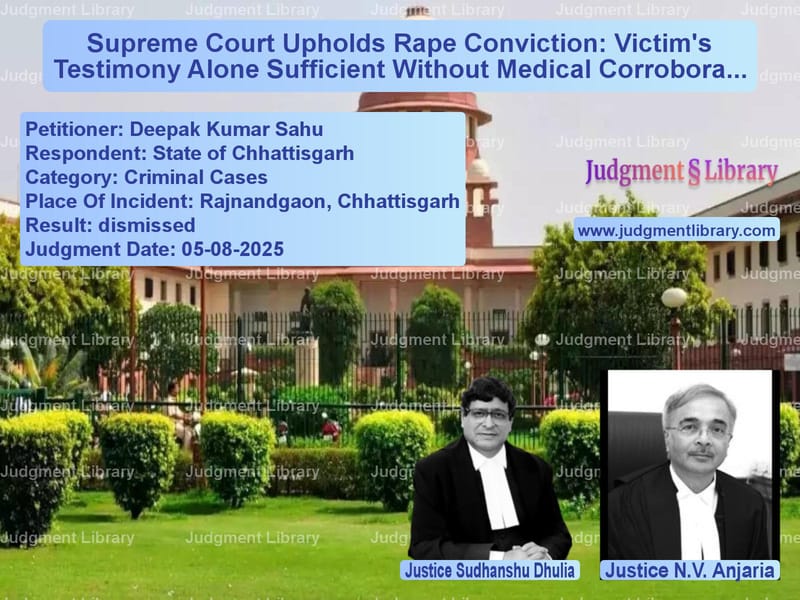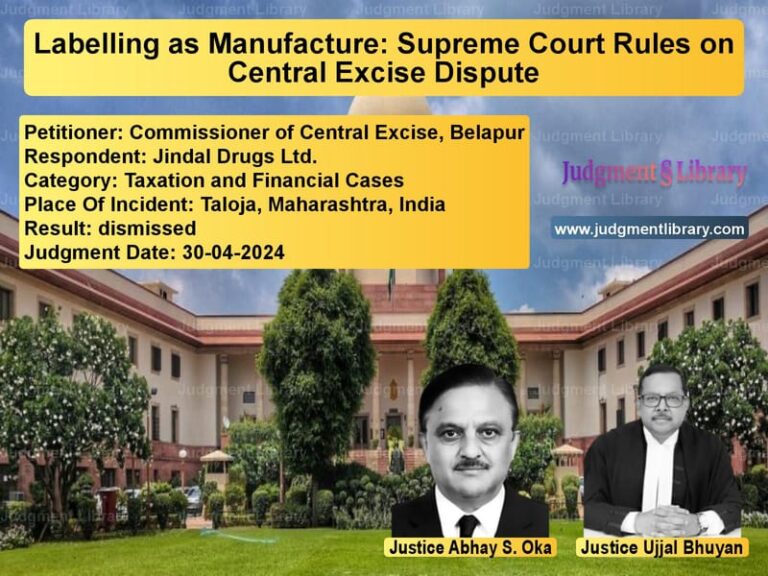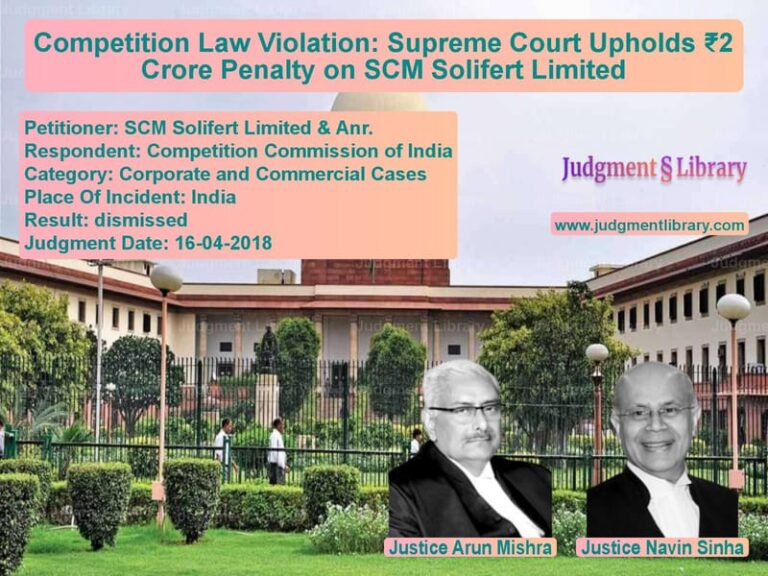Supreme Court Upholds Rape Conviction: Victim’s Testimony Alone Sufficient Without Medical Corroboration
In a powerful reaffirmation of legal principles protecting victims of sexual violence, the Supreme Court of India recently dismissed an appeal challenging the conviction of a man for raping a 15-year-old girl, emphasizing that the victim’s testimony alone can be sufficient for conviction even without medical corroboration. The judgment, which upholds a ten-year rigorous imprisonment sentence, reinforces crucial legal doctrines that prioritize the credibility of sexual assault survivors’ accounts over technical medical evidence deficiencies.
The case involved Deepak Kumar Sahu, who was convicted for offenses under Section 450 of the Indian Penal Code (house trespass) and Section 376(2) IPC (rape) along with provisions of the Protection of Children from Sexual Offences (POCSO) Act. The incident occurred on April 3, 2018, when the victim, aged 15 years and 5 months, was alone at home with her younger brother while their parents attended a funeral in a neighboring village.
The Prosecution’s Case
According to the prosecution, the appellant-accused entered the victim’s house around noon and sent her 11-year-old brother to buy chewing tobacco. Once the brother left, the accused forced the victim onto a cot in the porch, gagged her mouth, and committed rape. When the brother returned, the accused fled after threatening the victim not to disclose the incident.
The victim immediately went to her cousin sister Dushyantin’s house in the neighborhood and informed her about the assault. Through Dushyantin’s mobile phone, she contacted her cousin brother Khomendra, who had accompanied her parents to the funeral. The parents rushed back home, where the victim narrated the entire incident, leading to the filing of a police complaint and registration of FIR.
The Appellant’s Arguments
The appellant’s counsel, Mr. Manish Kumar Saran, advanced three main arguments challenging the conviction. First, he contended that “the prosecution had failed to establish its case beyond the reasonable doubt and that it was not possible to rule out the theory of innocence of the appellant.” He argued that “the evidence of the prosecutrix could not be relied on and needed to be analysed with caution when the medical report was not categorical to confirm the offence of sexual assault and rape on the victim.”
Second, the counsel claimed that “there were contradiction between the evidence of the victim (PW-2) and her younger brother (PW-9).” Third, he argued that “the prosecution could not establish that the victim was minor on the date of commission of offence so as to attract the provisions of POCSO Act, 2012.”
The Supreme Court’s Analysis
The Supreme Court bench comprising Justices Sudhanshu Dhulia and N.V. Anjaria systematically addressed each argument, beginning with the minor age issue. The court found “cogent and reliable evidence in the nature of 8th standard marksheet of the victim which showed her date of birth to be 09.10.2002.” This was corroborated by the victim’s mother (PW-1) and father (PW-3), establishing that on the incident date, “the age of the victim was 15 years 5 months 24 days.”
The court then examined the victim’s testimony in detail, noting that she clearly described how the accused “forced her to lay down on the cot which was in the porch of the house and gagged her mouth. She stated that after disrobing her, the accused committed a misdeed and raped her.” Her evidence was found to be “clear and consistent in the narration of the incident, and natural as well.”
The testimony of the victim’s brother Mayank (PW-9), a child witness, provided crucial corroboration. He stated that when he returned with the tobacco, “he saw the accused gagging his sister’s mouth with his hand and had laid her down on the cot. It was stated that his sister at that time was seen without clothes and that the accused was also noticed in a similar state, off the trouser.”
Medical Evidence and Legal Principles
The court acknowledged that medical examination showed “no injury marks on the private parts of the victim” though the hymen was ruptured and healing. However, the judgment emphasized that “the contention that non-availability of emphatic medical evidence about occurrence of physical intercourse and absence of external injury marks make it imperative to doubt and disregard the evidence of the prosecutrix, could hardly be countenanced.”
The court extensively cited precedent to establish that “In cases of offences committed under Section 376, IPC, when the story of the victim girl as told in the evidence is found credit-worthy, the apparent insufficiency of medical evidence pitted against acceptable testimony of the victim, the latter would prevail.”
Quoting from State of Punjab vs. Gurmit Singh, the court noted: “In the absence of injury on the private part of the prosecutrix, it cannot be concluded that the incident had not taken place or the sexual intercourse was committed with the consent of the prosecutrix.”
The judgment reinforced the principle from State of Himachal Pradesh vs. Manga Singh that “The conviction can be sustained on the sole testimony of the prosecutrix, if it inspires confidence. The conviction can be based solely on the solitary evidence of the prosecutrix and no corroboration be required unless there are compelling reasons which necessitate the courts to insist for corroboration of her statement.”
The court further quoted: “Corroboration of the testimony of the prosecutrix is not a requirement of law; but a guidance of prudence under the given facts and circumstances. Minor contractions or small discrepancies should not be a ground for throwing the evidence of the prosecutrix.”
In a recent judgment cited by the court, Lok Mal alias Loku vs. State of Uttar Pradesh, it was observed: “Merely because in the medical evidence, there are no major injury marks, this merely cannot a be a reason to discard the otherwise reliable evidence of the prosecutrix. It is not necessary that in each and every case where rape is alleged there has to be an injury to the private parts of the victim and it depends on the facts and circumstances of a particular case. We reiterate that absence of injuries on the private parts of the victim is not always fatal to the case of the prosecution.”
Addressing Discrepancies in Testimony
The court dismissed the appellant’s argument about discrepancies between the victim’s testimony and her brother’s evidence, finding “no material discrepancy could be noticed by the Court on comparison of the evidence of the two witnesses.” The judgment emphasized that “discrepancies in evidence which are of minor nature not going to the root have to be ignored.”
Citing State of Himachal Pradesh vs. Lekh Raj, the court observed that “minor variation in the accounts of the witnesses are often the hallmark of the truth of their testimony and the discrepancies are found to be of minor character not going to the root of the prosecution story, they need not be given undue importance.”
Broader Legal Philosophy
The judgment reflected a sensitive approach towards sexual assault cases, quoting from Bharwada Bhoginbhai Hirjibhai vs. State of Gujarat: “In the Indian setting, refusal to act on the testimony of a victim of sexual assault in the absence of corroboration as a rule, is adding insult to injury. Why should the evidence of the girl or the woman who complains of rape or sexual molestation be viewed with the aid of spectacles fitted with lenses tinged with doubt, disbelief or suspicion?”
The court also referenced State of Rajasthan vs. N.K. The Accused, which observed that “an unmerited acquittal encourages wolves in the society being on the prowl for easy prey, more so when the victim of crime are helpless females.”
Quoting Gurmit Singh, the judgment noted that “the rapist not only violates the victim’s privacy and personal integrity, but inevitably causes serious psychological as well as physical harm in the process. It was stated that the rape is not merely a physical assault and subsequently destructs the whole personality of the victim.”
Final Ruling
After comprehensive analysis, the Supreme Court concluded that “victim’s evidence was entirely probable, natural and trustworthy who with lucidity narrated the whole incident about commission of offence against her by the accused. There exists no reason, much less compelling reasons, to disbelieve and discard her testimony.”
The court found that “The High Court was wholly justified in upholding and confirming the conviction and sentence awarded to the appellant convict, by the trial court” and accordingly dismissed the criminal appeal.
Significance of the Judgment
This judgment represents a significant reinforcement of legal protections for sexual assault survivors in India. By unequivocally stating that a victim’s testimony alone can be sufficient for conviction, the Supreme Court has strengthened the position of survivors in the criminal justice system.
The decision clarifies that absence of medical evidence or external injuries cannot automatically discredit a victim’s account, recognizing the varied circumstances in which sexual assaults occur. This is particularly important in cases involving children and adolescents, where physical resistance might be minimal due to fear, intimidation, or physical disparity.
The judgment also serves as a reminder to courts at all levels to approach sexual assault cases with sensitivity, avoiding hyper-technical scrutiny of minor discrepancies and recognizing the trauma that victims experience. By citing multiple precedents spanning decades, the Supreme Court has created a consistent jurisprudential framework that prioritizes substantive justice over procedural technicalities in sexual violence cases.
This ruling will likely have far-reaching implications for how lower courts evaluate evidence in sexual assault cases, potentially leading to more convictions where victims’ testimonies are credible, even when medical or other corroborative evidence is limited.
Petitioner Name: Deepak Kumar Sahu.Respondent Name: State of Chhattisgarh.Judgment By: Justice Sudhanshu Dhulia, Justice N.V. Anjaria.Place Of Incident: Rajnandgaon, Chhattisgarh.Judgment Date: 05-08-2025.Result: dismissed.
Don’t miss out on the full details! Download the complete judgment in PDF format below and gain valuable insights instantly!
Download Judgment: deepak-kumar-sahu-vs-state-of-chhattisgar-supreme-court-of-india-judgment-dated-05-08-2025.pdf
Directly Download Judgment: Directly download this Judgment
See all petitions in Juvenile Justice
See all petitions in Bail and Anticipatory Bail
See all petitions in Attempt to Murder Cases
See all petitions in Custodial Deaths and Police Misconduct
See all petitions in Other Cases
See all petitions in Judgment by Sudhanshu Dhulia
See all petitions in Judgment by N.V. Anjaria
See all petitions in dismissed
See all petitions in supreme court of India judgments August 2025
See all petitions in 2025 judgments
See all posts in Criminal Cases Category
See all allowed petitions in Criminal Cases Category
See all Dismissed petitions in Criminal Cases Category
See all partially allowed petitions in Criminal Cases Category







